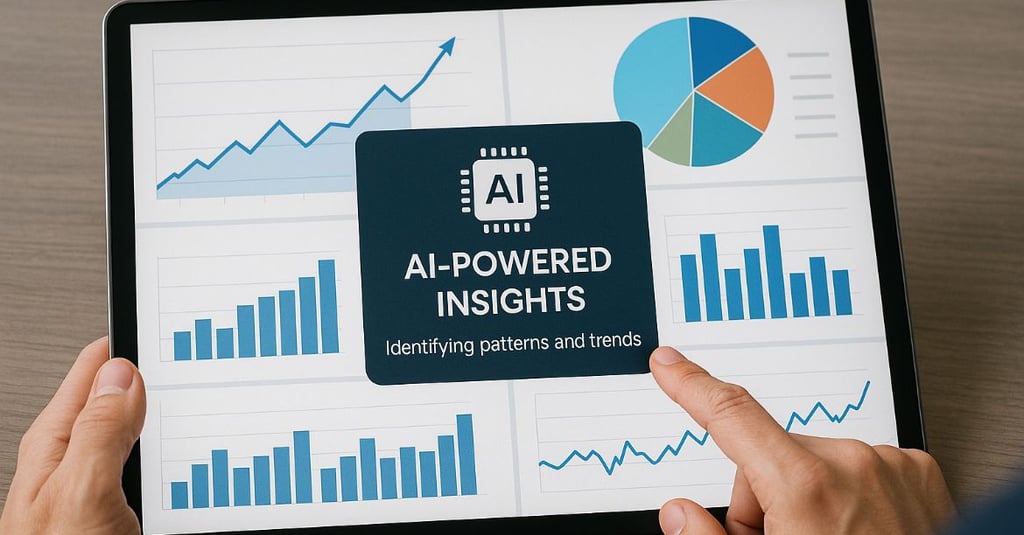
Master Tech skills on the go...
How to Use AI for Data Analysis and Insight
Unlock How to Use AI for Data Analysis: automate cleaning, reveal trends, build predictive models, and generate actionable NLP insights for faster smarter data-driven decisions.
AI TOOLS & PROMPT ENGINEERING
By OnlineTechSkills Editorial Team
10/4/20257 min read


Data is pouring in from every angle, sales numbers, website clicks, customer feedback, operational metrics. For freelancers, solopreneurs, and small teams, turning that raw information into actionable insight can feel overwhelming. Manual spreadsheets and one-off scripts are fine for small data sets, but what happens when you scale to thousands of rows or complex relationships?
That’s where AI comes in. Modern generative models and AutoML tools can help you clean, explore, visualize, and interpret data far faster and often more accurately than you could alone. In this guide, we’ll walk through how to weave AI into every step of your data workflow, from ingestion to insight. You’ll learn about key AI tools, prompt-engineering techniques for analysis, real-world examples, and actionable steps to level up your data game.
Why AI Matters in Data Analysis
Traditional data analysis relies on handcrafted queries, manual charting, and statistical know-how. AI-driven analysis brings three big advantages:
Speed and Scalability AI can sift through millions of data points in seconds, surfacing trends and anomalies in real time.
Advanced Pattern Recognition Machine learning models detect complex relationships like seasonal sales cycles or hidden customer segments that simple filters or pivot tables might miss.
Natural-Language Interaction Instead of writing SQL or Python, you can ask AI in plain English: “Show me last quarter’s top 5 customer churn triggers.”
For freelancers looking to boost their skill set, AI-powered data analysis is a must-have. If you’re mapping out your skills roadmap, check Top 7 Tech Skills to Learn in 2025—No Experience Needed to see where data analysis fits in.
Core Components of an AI Data Workflow
Before diving into tools and prompts, let’s outline the typical steps in a data analysis pipeline and where AI can help:
Data Ingestion Collect data from APIs, spreadsheets, databases, or IoT sensors.
Data Cleaning and ETL Identify missing values, normalize formats, and transform structures.
Exploratory Data Analysis (EDA) Generate summary statistics, pivot tables, and initial charts.
Feature Engineering Create new metrics (e.g., rolling averages, ratios) that sharpen insights.
Modeling and Pattern Detection Apply machine learning or statistical models to predict or classify.
Visualization and Reporting Build dashboards and narratives that tell the story behind the numbers.
Automation and Deployment Schedule regular retraining, alerts, and updates to keep insights flowing.
Throughout each stage, AI tools from conversation-driven assistants to full AutoML platforms can accelerate your work. Let’s explore them in detail.
Data Ingestion: Streamlining Collection
The first hurdle is often getting data out of its silos and into one place. AI tools can:
Auto-Extract from Documents Use OCR and NLP services (like Azure Form Recognizer or Amazon Textract) to pull tables from PDFs or scanned invoices.
Connect to APIs Low-code platforms like Make or Zapier can ferry data from Stripe, Google Analytics, or Salesforce into your database no code required. Learn how to pick the right automation platform in IFTTT vs Zapier vs Make: Which to Use When.
Unify Data Sources Tools like Fivetran, Stitch, or Airbyte automatically sync data from dozens of cloud apps into your data warehouse.
By automating ingestion, you spend zero time on grunt work and more time analyzing.
Data Cleaning and ETL: AI-Assisted Transformation
Dirty data is the bane of analysis. Here’s how AI helps:
Anomaly Detection AI algorithms spot outliers dates in the future, prices of zero, or duplicate entries, so you can correct them before analysis.
Auto-Categorization Models can classify free-text fields (e.g., support tickets or reviews) into categories, saving hours of manual tagging.
Natural-Language ETL Conversational interfaces let you say:
Combine Sheet1 and Sheet2 on customer_id, then fill missing dates with the nearest previous date.
Tools like Transform and Trifacta handle these instructions natively.
For more on harnessing AI for structured data work, check How to Use AI for Data Analysis and Insight.
Exploratory Data Analysis: Conversational Insights
Once your data is tidy, you need to ask the right questions. With AI, you can:
1. Generate Summary Statistics
Prompt-driven EDA tools take commands like:
Summarize the sales_data table: show mean, median, standard deviation for revenue and quantity columns.
And return a neat table of stats.
2. Automatic Chart Suggestions
Platforms like ThoughtSpot, Zoho Analytics, or Power BI’s AI visuals can recommend chart types, histograms for distributions, line charts for trends based on your data’s shape.
3. Natural-Language Queries
With NLP-focused services (e.g., Metabase’s “Ask a question” or Amazon QuickSight Q), you type:
What were the top 3 products by revenue in Q1 2025?
And get both the answer and the underlying SQL query for transparency.
These capabilities democratize data exploration, letting non-technical stakeholders ask probing questions.
Feature Engineering: Teaching AI Your Metrics
Raw data often needs context. Creating derived features like customer lifetime value or rolling averages, boosts model performance and insights:
Automated Feature Suggestion AutoML platforms like Google Cloud AutoML Tables or H2O.ai scan your data and propose new features (e.g., interaction terms) that improve predictive power.
Custom Transformer Prompts In Python notebooks, use AI to generate code snippets for feature creation:
Write a Pandas function to calculate a 7-day rolling average of daily active users.
Prompt engineering helps you generate and refine these code snippets quickly, even if you’re not a data scientist. Curious about these AI coding assistants? Explore AI-Powered Learning: How to Use ChatGPT as a Personalized Coding Tutor.
Modeling and Pattern Detection: From Prediction to Prescription
With features in hand, it’s time to train models or run advanced analysis:
1. AutoML for Rapid Prototyping
Platforms like DataRobot, Amazon SageMaker Autopilot, and Microsoft Azure ML Studio let you upload data, select a target, and let the AI choose algorithms, tune hyperparameters, and compare results. You get:
Leaderboard of models ranked by accuracy
Visual explanations of feature importance
One-click deployment endpoints
2. Code-First Modeling with AI Help
If you prefer Python or R:
Ask ChatGPT to scaffold a modeling script:
Write a scikit-learn pipeline to preprocess numeric and categorical features, then train a random forest classifier.
Request explanations of metrics:
Interpret this classification report: precision=0.82, recall=0.76, f1-score=0.79.
3. Anomaly and Trend Detection
Unsupervised techniques like clustering or change-point detection surface hidden patterns. Prompt ChatGPT:
Explain how to use the Prophet library for time-series anomaly detection on weekly sales data.
By combining AutoML’s speed with AI-driven code generation, you get the best of both worlds: rapid results and full control.
Visualization and Reporting: AI-Enhanced Dashboards
Raw numbers are fine for analysts but stakeholders crave visuals and narratives. Here’s how to bring AI into your reporting:
1. AI Narrative Generation
Tools like Tableau’s “Explain Data” or Power BI’s “Smart Narratives” automatically generate text summaries for each chart. You can also prompt ChatGPT:
Based on this sales_by_region chart, write a 3-sentence summary highlighting the fastest-growing region and any anomalies.
2. Custom Dashboard Embeds
If you build dashboards in Vue.js:
Use a ChatGPT API call to fetch narrative text on page load.
Combine with Chart.js graphs for a fully dynamic experience; learn how in How to Create Dynamic Dashboards with Vue.js and Chart.js.
3. Scheduled AI Reports
With Zapier or Make:
Trigger: New data landing in your warehouse.
Action: Send summary prompt to ChatGPT.
Action: Insert chart images and AI narrative into Google Slides or Notion.
Action: Email the report to stakeholders.
Automation ensures no one forgets the monthly KPIs meeting.
Case Study: Freelance Ecommerce Analyst
Background: Emma, a freelance ecommerce analyst, supports three Shopify stores. She used to spend days pulling sales data, generating pivot tables, and writing summaries.
AI-Driven Transformation:
Ingestion and Cleaning:
Fivetran syncs Shopify to BigQuery.
A scheduled Cloud Function triggers an AI-driven cleaning script scaffolded by ChatGPT.
Exploration:
Emma asks Metabase’s NLP interface: “Show me the top 5 products by profit margin.”
She refines analysis via ChatGPT-generated Python code for deeper segmentation.
Modeling:
Google AutoML identifies churn predictors.
Emma uses ChatGPT to deploy a prediction endpoint in Flask.
Reporting:
A Make scenario calls ChatGPT with updated sales metrics and auto-generates a Notion report.
Emma reviews, adds context, and publishes.
Outcome:
Report prep went from 16 hours per month to under 2 hours.
Clients saw a 12% lift in average order value after Emma’s targeted upsell recommendations.
Emma credits AI integration for her ability to serve more clients under tighter deadlines.
Ethics and Best Practices
AI in data analysis is powerful, but it comes with responsibilities:
Bias Detection: Check models for skewed outcomes especially in customer segmentation or predictive tasks.
Data Privacy: Mask or anonymize personal data when feeding datasets into third-party AI services.
Explainability: Use SHAP or LIME to interpret model predictions and share transparent explanations with stakeholders.
Verification: Always cross-check AI-generated code snippets or insights against official documentation or domain expert review.
Ethical awareness ensures your AI analyses drive real value without unintended harm.
Skills and Resources for Your AI Data Journey
To master AI-driven analysis, build these skills:
Python and SQL Fundamentals
Data Visualization Libraries (Matplotlib, Seaborn, or Chart.js)
Prompt Engineering
AutoML Platforms
Low-Code Automation (Zapier, Make)
Cloud Data Warehousing (BigQuery, Snowflake)
Accelerate your learning with structured courses on Best Online Platforms to Learn Practical Tech Skills in 2025. And if you’re curious how to break into tech with no degree, check How to Break Into Tech Without a Degree or Tech Background.
Action Steps: Implement AI-Powered Analysis
Audit Your Data Sources List all where your data lives: Sheets, Shopify, CRMs, IoT logs.
Automate Ingestion Pick an ETL tool, Fivetran, Airbyte, or Zapier and build your first sync.
Experiment with EDA Use an NLP-based EDA tool or ChatGPT to generate summary stats and initial charts.
Define a Modeling Task Choose a simple predictive problem: forecast sales, classify support tickets.
Use AutoML and AI Prompts Run AutoML for rapid prototyping. Use ChatGPT to generate and refine your modeling scripts.
Build an AI-Driven Report Automate weekly reports via Make or Zapier, including AI-generated narratives and visuals.
Review and Iterate Gather stakeholder feedback and refine your prompts, models, and automations accordingly.
Final Thoughts
Integrating AI into your data analysis workflow transforms you from a number-cruncher into a strategic partner. With the right blend of AI tools, solid prompt engineering, and cross-platform automation, you’ll turn raw data into real, revenue-driving insights in a fraction of the time.
Whether you’re freelancing, building a tech career, or scaling your online business, mastering AI for data analysis is a skill that pays dividends. Start small, build iteratively, and watch as your analytical capacity and business impact soars.
Insights
Explore our free and top ranking blogs for in-demand tech skills.
CONTACT US
Support
support@onlinetechskills.com
© 2025. All rights reserved.